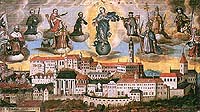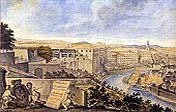Iconography of Český Krumlov
The portrayal of Česky Krumlov through the ages ("iconography") has had a respectable tradition that reaches back to the 16th century. It is proved by hundreds of vistas collected by both domestic and foreign museums, archives, galleries, castles and private collections. Dictionaries describe "vista" as a view of a town, its parts or a piece of landscape with buildings either painted, drawn or done as graphic art, relief or photography.
A copy of the painting "Division of the Roses" from the 19th century has its origin from a lost original painting from approximately the 1550's. A stylish area "mosaic" under the castle of real buildings is situated under a realistic scene of the Krumlov Castle. The vista of Cesky Krumlov from 1591 discovered on the background of "Portrait of Jan von Pernštejn" has mainly an objective outlook. A continuation of Krumlov iconography developed from the mid-17th century. The most significant Baroque masterpieces are the southern view with Kájovska Gate and St. Vitus church on the "Icon of St. Joseph" (1650's), an overpainted canvas of "St. Franciscus Xaverius, a protector againts the plague" (1681), a panoramic southern town view from the 1660's created by glued pieces of wood and straw, two Castle vistas by G. A. Hörner from the 1740's, a picture of "Český Krumlov under the protection of Virgin Mary and the Saints" from 1727-28, and a view emphasizing the typical town dominants by a well-known drawer Friedrich Bernard Werner (1740's).
|
|
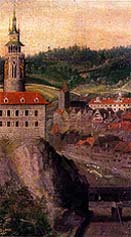
|
|

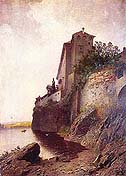 The number of Krumlov
vistas increased tremendously during the Classicist and Romantic
periods, when the town was discovered by many artists from Prague
and abroad. The interest of painters and graphic artists in the
poetic and historical seat situated in an unusual dramatic
landscape boomed at the beginning of the 20th century. Worthy of
mention is J. Langweil, K. Postl, J. Janscha, K. Würbs, F. Loos, A.
Haun, A.F.Kunike, A. Kirnig and V. Jansa.
The number of Krumlov
vistas increased tremendously during the Classicist and Romantic
periods, when the town was discovered by many artists from Prague
and abroad. The interest of painters and graphic artists in the
poetic and historical seat situated in an unusual dramatic
landscape boomed at the beginning of the 20th century. Worthy of
mention is J. Langweil, K. Postl, J. Janscha, K. Würbs, F. Loos, A.
Haun, A.F.Kunike, A. Kirnig and V. Jansa.
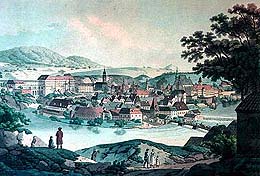
|
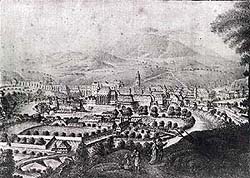
|
The court painter Ferdinand Runk and his aristocratic student Paulina zu Schwarzenberg paid systematic attention to Krumlov's motives in the 19th century. Another Schwarzenberg' painter Karl Zenker followed him in the forties. Bedrich Havranek as well created numerous drawings and oil paintings during his stays in Krumlov in the course of the following decades.
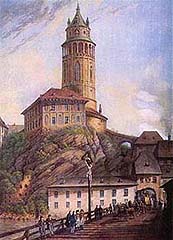
|
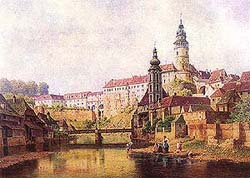
|
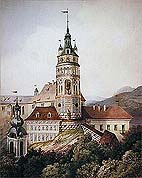
|
At the beginning of the 20th century, Ludvik Kuba and mainly Egon Schiele, author of the renowned cycle "Dead City", became well known as admirers of Česky Krumlov. His fateful encounter with the magically secret birthplace of the artist's mother accelerated his maturation into a modern artist. Krumlov became his lifelong theme. The documentary outlines of vista creation in the 20's and 30's were best represented by the painter Wilhelm Fischer. Also historically valuable are the works of the postwar artist Bohuslav Coufal, who documented the forgotten corners of urban Krumlov.
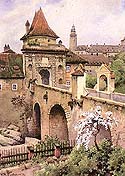
|
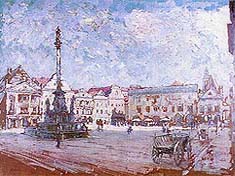
|
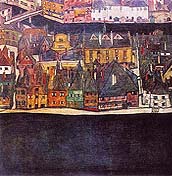
|
 After the postcard became
a stamp in 1880, Šumava and Pošumaví became the subject of interest
of so-called travelling photographers. At the beginning of the
1870's, the photo studio of F. Krátký from Kolín nad Labem made a
postcard of Český Krumlov. A native from Ceske Žleby, Gotthard
Zimmer, who came to town in the 1880's to set up a studio played a
great role in Cesky Krumlov's photographic art tradition. His
studio was then taken over by Josef
Seidel (1859-1935) whose pictures of both Sumava and Český
Krumlov belong to the classics of local iconography and are often
of great graphical value. Art of vistas by Josef
Wolf (1864-1938) give evidence of a high standard of the local
photographic production.
After the postcard became
a stamp in 1880, Šumava and Pošumaví became the subject of interest
of so-called travelling photographers. At the beginning of the
1870's, the photo studio of F. Krátký from Kolín nad Labem made a
postcard of Český Krumlov. A native from Ceske Žleby, Gotthard
Zimmer, who came to town in the 1880's to set up a studio played a
great role in Cesky Krumlov's photographic art tradition. His
studio was then taken over by Josef
Seidel (1859-1935) whose pictures of both Sumava and Český
Krumlov belong to the classics of local iconography and are often
of great graphical value. Art of vistas by Josef
Wolf (1864-1938) give evidence of a high standard of the local
photographic production.
(jm)




